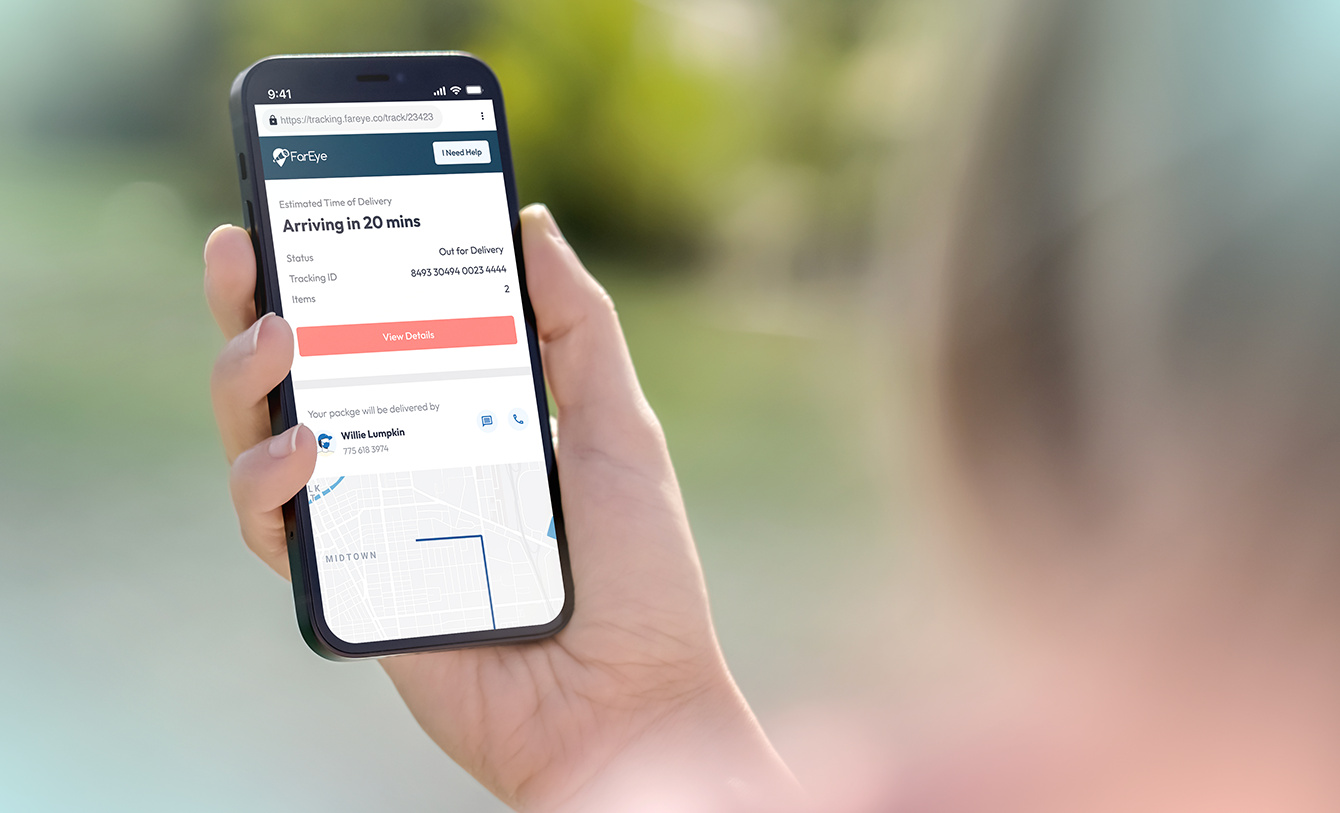- Last-Mile
Enhancing Last Mile Delivery Efficiency with Electric Vehicles
Table of Contents
- The Rising Role of Electric Vehicles in Last Mile Delivery
- Why Using Electric Vehicles for Last Mile Delivery is a Game Changer
- Key Benefits of EVs for Urban Logistics
- Challenges in Adopting EVs for the Last Mile
- Solutions for Overcoming EV Challenges
- Technology and Trends Shaping EV Adoption
- Optimize Your Electric Last Mile Fleet with FarEye
- FAQs

Urban regulations, rising e-commerce volumes, and stricter sustainability reporting are reshaping last mile delivery operations. Analysts estimate that last mile transport revenue could reach USD 446 billion by 2034. Projections also indicate that e-commerce logistics alone may generate approximately 5.5 million metric tonnes of CO₂ each year by 2032.
Faced with this dual challenge of rising demand and rising emissions, many fleets are turning to electric vehicles for last mile delivery as a practical response. Electric vehicles bypass low-emission-zone surcharges, run on stable electricity rates, and provide precise carbon data for auditors. They also satisfy customer expectations for quieter, low-impact service.
Let us learn how using electric vehicles for last mile delivery can reconcile growth with sustainability and what enterprises should consider when scaling an electric fleet.

The Rising Role of Electric Vehicles in Last Mile Delivery
Regulatory pressure, investor expectations, and consumer preferences are converging around lower-carbon operations. As a result, fleets that introduce electric vehicles for last mile delivery position themselves for continued urban access and reputational benefit.
Forward-looking carriers also gain early experience with charging logistics, battery analytics, and range forecasting, skills that will become non-negotiable as more cities tighten emissions rules.
E-commerce Growth and Urban Demands
Online sales continue to rise, and most of those parcels are transported through densely populated business districts or residential corridors. Deploying EV fleets for last mile delivery helps companies meet strict delivery windows while curbing localized pollution.
Policy Momentum and Sustainability Mandates
Tighter regulations are now commonplace in global cities. Electric vehicles for last mile delivery help companies comply with new access rules and emissions standards, making them an asset for meeting both operational and legal requirements.
Fleets running electric vans for last mile delivery avoid daily surcharges and secure permits more easily than diesel operators. In addition, many municipal tender processes now award points for demonstrated decarbonization, giving electrified carriers an advantage in new contract bids.
Why Using Electric Vehicles for Last Mile Delivery is a Game Changer
A well-planned shift to using electric vehicles for last mile delivery delivers value on several fronts. Enterprises that standardize electric vehicles for last mile delivery discover new operating models enabled by regenerative braking, dynamic charging windows, and advanced telematics.
- Lower Costs and Urban Compliance
Electric drivetrains cut fuel spend and reduce moving parts, which lowers workshop downtime. These savings can be reinvested in advanced dispatch tools or driver incentives that further elevate service quality. At the same time, using EVs for last mile delivery helps ease through environmental checkpoints, freeing route planners from detour calculations linked to emission penalties.
- Meeting Emissions Standards
Reporting on emissions is now an expected part of business transparency. Electric vehicles for last mile delivery produce clear data trails that support sustainability goals and provide verifiable progress to stakeholders.
Data loggers in every electric vehicle for last mile delivery capture kilowatt hours consumed per route, mileage, and idle time, supplying auditors with verifiable carbon figures. Continuous tracking also enables quarterly targets rather than annual catch-up cycles, keeping sustainability programs on schedule.
- Fulfilling Customer Demand for Green Delivery
Today's buyers are increasingly seeking greener delivery options. Adopting electric vehicles for last mile delivery demonstrates a commitment to sustainability can lift repeat intent in sustainability-sensitive segments
Shoppers may switch brands or pay a small premium when greener options are available. Displaying a "delivered by electric vehicles" badge at checkout converts that sentiment into revenue. Marketing teams can reinforce the message with post-purchase emails that summarize the emissions saved per order.

Key Benefits of EVs for Urban Logistics
As fleets grow, electric vehicles for last mile delivery are offering solutions to long-standing challenges in city logistics. The benefits go beyond simple emissions reductions and touch nearly every aspect of daily operations.
- Reducing Delivery and Ownership Costs
Electricity rates are typically more stable than diesel prices, improving budgeting accuracy over multi-year horizons. Because regenerative braking lessens the wear on discs and pads, electric vehicles also incur fewer unscheduled repairs, allowing fleets to stretch maintenance intervals without jeopardizing safety.
- Lowering Emissions and Boosting Sustainability
Each diesel-to-EV swap eliminates tailpipe CO₂, NOₓ, and particulate matter. A cluster of electric vehicles can, therefore, help organizations meet emission-based targets years ahead of schedule. The cleaner profile also supports corporate ESG narratives that resonate with investors and employees alike.
- Improving Efficiency and Enterprise Reputation
Efficient, quiet operations from electric vehicles for last mile delivery help reduce urban congestion and project a positive image. Businesses known for dependable, low-impact service powered by electric vehicles for last mile delivery can secure premium retailer partnerships and earn favorable local media coverage.
Challenges in Adopting EVs for the Last Mile
Transitioning to electric vehicles for last mile delivery introduces hurdles that must be managed thoughtfully. Understanding these barriers helps enterprises introduce electric vehicles for last mile delivery without operational disruption.
- Investment and Transition Barriers
The initial capital required to acquire electric vehicles for last mile delivery is often higher than for conventional models. This expense includes the cost of the vehicles themselves and the necessary upgrades to the charging infrastructure and power supply at depots.
Higher initial prices and charger installations demand advanced capital allocation models. Finance teams must weigh lease-versus-purchase scenarios, residual-value projections, and potential incentives while ensuring that electric vehicles for last mile delivery do not strain liquidity.
- Charging Infrastructure and Range
Route designers need accurate state-of-charge predictions under varying payloads, temperatures, and gradients. Until public networks mature, depots may require battery buffer systems to prevent peak-demand penalties while supporting electric vehicles for last mile delivery on tight turnarounds.
- Route Planning and Workforce Training
Electric vehicles for last mile delivery have different range profiles compared to traditional vans. Route planners must factor in battery capacity, charging station locations, and delivery densities, all while maintaining high levels of efficiency. Adapting existing software or investing in new planning tools becomes essential to optimize for these unique constraints.
Drivers and dispatchers need new training to operate and manage electric vehicles for last mile delivery. For example, they must understand battery management, regenerative braking, and charging procedures. Change management is also crucial, as employees may be unfamiliar with or resistant to new technologies and workflows.

Solutions for Overcoming EV Challenges
Strategic partnerships and modular planning enable enterprises to manage the complexities of a last mile delivery electric vehicle rollout. Choosing phased approaches keeps electric vehicles for last mile delivery scalable across varied geographies.
- Charging Partnerships and Mixed Fleets
Public-private charging alliances help depots add fast chargers without waiting for lengthy grid upgrades. Utility partners often co-invest in infrastructure, lowering upfront capital outlay and stabilizing energy costs through long-term supply contracts.
While the network scales, managers maintain steady service levels by pairing electric vehicles for last mile delivery with conventional or hybrid vans on the same dispatch board. Daily delivery data then indicates which routes can be migrated next, allowing for a phased transition that protects asset utilization and customer commitments.
- Advanced Routing and Real-time Data
Machine-learning engines ingest traffic, elevation, and energy consumption to allocate tasks among electric vehicles used for last mile delivery, all in a single dashboard. Real-time state-of-charge metrics feed predictive arrival times, ensuring each electric vehicle for the last mile delivery loop ends with reserve capacity. Alerts prompt mid-shift charger detours only when needed, preventing unscheduled stops for electric vehicles.
- Flexible Urban Logistics Models
Satellite micro-hubs positioned near dense neighborhoods reduce delivery distances and allow larger trucks to deliver freight outside congestion zones. Smaller electric vehicles for last mile delivery then complete doorstep deliveries with minimal idle time, eliminating the curbside bottlenecks that plague heavier vans.
Parcel lockers further enhance first-attempt success, reducing costly reruns that would otherwise hinder EV range advantages. These modular assets can be redeployed as demand shifts, giving operators a scalable, low-emission footprint.

Technology and Trends Shaping EV Adoption
Software advances complement the hardware evolution of electric vehicles for last mile delivery and embed intelligence throughout the delivery lifecycle. As digital tools mature, they amplify the advantages of using electric vehicles for last mile delivery.
- Telematics, Predictive Analytics, and Routing
Every van sends basic battery and mileage data to a central dashboard. EV routing software spots early signs of battery wear so mechanics can schedule repairs before the vehicle slows down. The same data also helps planners select the most efficient routes for electric vehicles in last mile delivery, saving both time and energy. - Microhubs and Smart Delivery Solutions
Small neighborhood hubs are stocked overnight. This lets electric vehicles for last mile delivery start the day close to customers and carry full loads right away. Shorter first legs result in less battery drain and provide room for an extra delivery run during busy periods. - Scaling Zero-emission Fleets
Some fleets subscribe to "battery-as-a-service" plans. The service provider owns the battery, and the fleet pays a predictable monthly fee. When newer, longer-range batteries arrive, they can be swapped into existing electric vehicles without buying new vans.
This keeps upfront costs lower and protects future flexibility. Fleet software matches vehicle range, charger availability, and parcel weight, sending these vehicles for last mile delivery only on routes they can complete comfortably. - Enhancing Efficiency and Customer Experience
If traffic or charging delays a stop, the system automatically updates the customer's delivery time. Drivers of electric vehicles for last mile delivery take a quick photo at the doorstep as proof, which is uploaded instantly for customer service teams. Clear updates reduce worry for the buyer and cut call-center workload for the carrier.
Optimize Your Electric Last Mile Fleet with FarEye
Widespread adoption of electric vehicles for last mile deliveries is no longer an emerging possibility; it is an operational imperative for enterprises that serve densely regulated markets. By using electric vehicles for last mile delivery, logistics leaders can cut emissions, protect margins, and satisfy customers who increasingly equate sustainability with service excellence.
Charging alliances, predictive analytics, and adaptive routing allow fleets to add substantial numbers of electric vehicles for last mile delivery without compromising reliability. FarEye's EV-ready routing suite supports this transition.
Our platform pairs range-aware route planning with real-time charger reservations, publishes precise ETAs, and records route-level carbon data for compliance reporting. Enterprises that act now to deploy comprehensive networks of electric vehicles for last mile delivery will secure a lasting competitive advantage as urban decarbonization accelerates. Contact FarEye to arrange a tailored demonstration and begin building a resilient zero-emission fleet.
Sources:
https://www.precedenceresearch.com/last mile-delivery-transportation-market
https://lastmileexperts.com/wp-content/uploads/2025/06/Innovation-Report-2025-Teaser.pdf
FAQs
- How do I pick routes for last mile EVs?
Prioritize high-density delivery zones to maximize EV utilization and minimize range anxiety. Focus on predictable stops with consistent dwell times, ensure access to depot or on-route charging, and use real-time telematics to monitor state of charge (SOC) and account for elevation changes, confirming adequate charge buffers for each route. - What changes in routing software are required?
Incorporate EV-specific parameters such as battery capacity, dynamic SOC, charger network mapping, and dwell-time energy use. Enhance optimization algorithms for range-aware routing, integrate charging locations, and enable dynamic rerouting based on real-time charge status and charger availability for seamless, cost-efficient electric last mile operations.

Komal Puri is a seasoned professional in the logistics and supply chain industry. As the AVP of Marketing and a subject matter expert at FarEye, she has been instrumental in shaping the industry narrative for the past decade. Her expertise and insights have earned her numerous awards and recognition. Komal’s writings reflect her deep understanding of the industry, offering valuable insights and thought leadership.
Let's Talk to Our Experts and Optimize Your Deliveries Today!
An expert from our team will reach out within 24 hours


